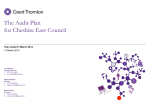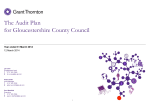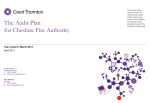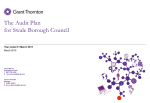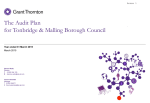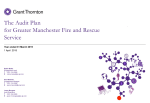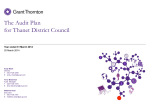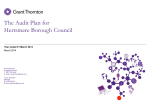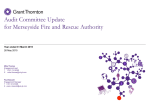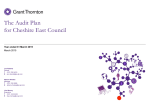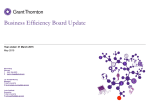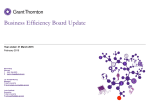Download The Audit Plan – template user guide
Transcript
The Audit Plan for Merseyside Fire & Rescue Authority Year ended 31 March 2014 29 May 2014 Robin Baker Engagement Lead T 0161 214 6399 E [email protected] Paul Basnett Audit Manager T 0161 214 6398 E [email protected] John Padfield Executive T 0161 214 6378 E [email protected] © 2014 Grant Thornton UK LLP | . The contents of this report relate only to the matters which have come to our attention, which we believe need to be reported to you as part of our audit process. It is not a comprehensive record of all the relevant matters, which may be subject to change, and in particular we cannot be held responsible to you for reporting all of the risks which may affect the Authority or any weaknesses in your internal controls. This report has been prepared solely for your benefit and should not be quoted in whole or in part without our prior written consent. We do not accept any responsibility for any loss occasioned to any third party acting, or refraining from acting on the basis of the content of this report, as this report was not prepared for, nor intended for, any other purpose. Contents Section 1. Understanding your business 2. Developments relevant to your business and the audit 3. Our audit approach 4. Significant risks identified 5. Other risks 6. Value for money 7. Results of interim audit work 8. Value for Money 9. Key dates 10. Fees and independence 11. Communication of audit matters with those charged with governance © 2014 Grant Thornton UK LLP | Understanding your business In planning our audit we need to understand the challenges and opportunities the Authority is facing. We set out a summary of our understanding below. Challenges/opportunities 1.Financial reporting There have been some changes to the CIPFA Code of Practice, including a clarification of the Code requirements around the timing of PPE valuations. The system of business rates retention has changed in 2013/14 which will have an impact on the Authority as a preceptor. 2. Strategic Partnerships and Collaboration 3. Financial pressures and efficiency agenda Construction of the Joint Control Centre Project is underway with completion expected during the summer of 2014. The co-location of the fire and police control room functions will provide an opportunity to deliver a more efficient and effective service to the public. The Authority is facing significant financial challenges – balancing service delivery against available resources is intensified at a time of reducing budgets. 4. Financial planning and reserves The Medium Term Financial Strategy recognises the need to maintain general reserves to provide resilience against financial uncertainty in the current climate of reduced funding levels. The level of the Authority's general and earmarked reserves is intended to decrease from £24.3m to £11m by 2017/18. Our response We will: We will: We will: We will: review the Authority's processes for complying with the requirements of the CIPFA Code of Practice, and in particular reviewing the process for ensuring asset valuations are materially correct. understand the Authority's progress in delivering a shared control centre with key partners, including any changes in timetable to the original plan. review the Authority's financial performance against its agreed budget and monitor performance through discussions with officers and review of the Authority's papers. consider the level of reserves and how the Authority balances competing demands for reserves, including avoiding redundancy and restructuring costs, with the need to minimise borrowing costs as part of a financial strategy. review the process for accounting for the Authority's share of business rates. © 2014 Grant Thornton UK LLP | consider the accounting impact of this in 2013/14 and beyond. review the Authority's plan for maintaining financial resilience in the medium term as part of our value for money conclusion. Developments relevant to your business and the audit In planning our audit we also consider the impact of key developments in the sector and take account of national audit requirements as set out in the Code of Audit Practice ('the code') and associated guidance. Developments and other requirements 1. Financial pressures and the efficiency agenda Reductions in central government funding mean fire authorities need to find future efficiencies. In March 2014 Grant Thornton published a report on Fire and Rescue Collaboration. 2. Pensions 3. Corporate Governance 4. Other requirements Changes to the Firefighters' pension scheme are due to be implemented from April 2015. As in previous years the Authority is required to summarise the operation of its system of internal control in its Annual Governance Statement. The Authority is required to submit a Whole of Government accounts pack on which we provide an audit opinion. There are transitional arrangements in place for the introduction of the 2015 scheme. There are changes planned to the Local Government Pension Scheme (LGPS) in 2013/14 and 2014/15. The explanatory foreword should explain the most significant areas of the accounts and be based on the information included in the financial statements. Our response We will: We will: We will: We will: review the Authority's performance against the 2013/14 budget, including consideration of performance against the savings plan. discuss the impact of the proposed changes to the schemes on the Authority during our meetings with senior management. assess the arrangements the Authority has in place for the production of the AGS. assess the amount of work required on the WGA pack. the AGS and the explanatory foreword to consider whether they are consistent with our knowledge. carry out this work in accordance with requirements. as part of our work on our VfM conclusion we will assess the longer term plans of the Authority and how these are being consulted upon and delivered. © 2014 Grant Thornton UK LLP | Our audit approach Ensures compliance with International Standards on Auditing (ISAs) Global audit technology Understanding the environment and the entity Understanding the business Inherent risks Significant risks Understanding management’s focus Other risks Evaluating the year’s results Material balances Develop audit plan to obtain reasonable assurance that the Financial Statements as a whole are free from material misstatement and prepared in all materiala respects with the CIPFA Code of Practice framework using our global methodology and audit software Devise audit strategy (planned control reliance?) Yes Extract your data Test controls Test of detail IDEA Substantive Substantive Analyse data analytical analytical Report output using relevant review review to teams parameters Tests of detail General audit procedures Note: a. An item would be considered material to the financial statements if, through its omission or nondisclosure, the financial statements would no longer show a true and fair view. Financial statements Conclude and report Creates and tailors audit programs © 2014 Grant Thornton UK LLP | No Stores audit evidence Documents processes and controls Significant risks identified 'Significant risks often relate to significant non-routine transactions and judgmental matters. Non-routine transactions are transactions that are unusual, either due to size or nature, and that therefore occur infrequently. Judgmental matters may include the development of accounting estimates for which there is significant measurement uncertainty' (ISA 315). In this section we outline the significant risks of material misstatement which we have identified. There are two presumed significant risks which are applicable to all audits under auditing standards (International Standards on Auditing – ISAs) which are listed below: Significant risk Description Substantive audit procedures The revenue cycle includes fraudulent transactions Under ISA 240 there is a presumed risk that financial statements may be misstated due to the improper recognition of revenue. The Authority’s main source of funding is its revenues from government grants and council tax precepts. These will be checked to external notifications Other operating income in the Authority’s accounts is likely to be significant and we will undertake audit procedures to address this risk. We are also required to consider the likelihood that expenditure could be misstated due to fraudulent manipulation and we will undertake audit procedures to address this risk. Work planned: Management over-ride of controls Under ISA 240 it is presumed risk that the risk of management over-ride of controls is present in all entities. Review and testing of revenue recognition policies. Sample testing of material revenue transaction streams. Testing of year-end revenue and operating expenses cut-off. Work completed to date: Review the journal control environment to identify any control weaknesses. Review and testing of journal entries made in the period April-December 2013. Further work planned: © 2014 Grant Thornton UK LLP | Review of accounting estimates, judgments and decisions made by management. Testing of journal entries for the remainder of the year. Review of unusual significant transactions. Other risks The auditor should evaluate the design and determine the implementation of the entity's controls, including relevant control activities, over those risks for which, in the auditor's judgment, it is not possible or practicable to reduce the risks of material misstatement at the assertion level to an acceptably low level with audit evidence obtained only from substantive procedures (ISA 315). In this section we outline the other risks of material misstatement which we have identified as a result of our planning. Other reasonably possible risks Operating expenses Description Work programme Creditors understated or not recorded in the correct period Work completed to date: We have documented the processes and controls in place around the accounting for operating expenses. We have carried out a walkthrough test to confirm the operation of controls is in line with our understanding. We have begun early substantive testing on a sample of operating expense incurred in the period April to December 2013. Work planned: Testing of the control account reconciliations. Review of monthly trend analysis of payments to identify any unusual or irregular movements which would be investigated. Documentation of the processes in place for month and year end accruals. Cut off testing of purchase orders and goods received notes (both before and after year end). Completion of testing of a sample of operating expense to ensure it has been accurately accounted for and in the correct period. © 2014 Grant Thornton UK LLP | Other risks (continued) The auditor should evaluate the design and determine the implementation of the entity's controls, including relevant control activities, over those risks for which, in the auditor's judgment, it is not possible or practicable to reduce the risks of material misstatement at the assertion level to an acceptably low level with audit evidence obtained only from substantive procedures (ISA 315). In this section we outline the other risks of material misstatement which we have identified as a result of our planning. Other reasonably possible risks Description Work programme Employee remuneration Employee remuneration accrual understated Work completed to date: We have documented the processes and controls in place around the accounting for employee remuneration. We have carried out a walkthrough test to confirm the operation of controls is in line with our understanding. We have begun early substantive testing on a sample of payments to employees covering the period April-December 2013. Work planned: Review of monthly trend analysis of payments to identify any unusual or irregular movements which would be investigated. Testing of the reconciliation between payroll system and general ledger. Completion of testing of a sample of employees for accuracy of payments and the agreement of employee remuneration disclosure to supporting documentation. © 2014 Grant Thornton UK LLP | Other risks (continued) The auditor should evaluate the design and determine the implementation of the entity's controls, including relevant control activities, over those risks for which, in the auditor's judgment, it is not possible or practicable to reduce the risks of material misstatement at the assertion level to an acceptably low level with audit evidence obtained only from substantive procedures (ISA 315). In this section we outline the other risks of material misstatement which we have identified as a result of our planning. Other reasonably possible risks Property, Plant & Equipment Description Work programme PPE activity not valid Work completed to date: We have documented the processes and controls in place around accounting for property, plant and equipment. We have carried out a walkthrough test to confirm the operation of controls is in line with our understanding. Work planned: Property, Plant & Equipment Revaluation measurement not correct Agreement of asset register to general ledger, accounts and supporting notes. Sample test of material PPE additions and disposals, including compliance with capitalisation requirements. Ensuring asset value of the three PFI fire stations, newly operational in 2013/14, has been appropriately reflected in the balance sheet. Revisit leasing arrangements in respect of Toxteth FireFit Hub, considering any implications for asset accounting. Work completed to date: Documentation of processes and controls. Work planned: © 2014 Grant Thornton UK LLP | Review of the analysis which demonstrates that the value of assets in the Authority's balance sheet is unlikely to materially differ from the amount that would be given by a full valuation carried out on 31 March 2014. Review and testing of depreciation and impairments, including evidence of review of Useful Economic Lives. Other risks (continued) The auditor should evaluate the design and determine the implementation of the entity's controls, including relevant control activities, over those risks for which, in the auditor's judgment, it is not possible or practicable to reduce the risks of material misstatement at the assertion level to an acceptably low level with audit evidence obtained only from substantive procedures (ISA 315). In this section we outline the other risks of material misstatement which we have identified as a result of our planning. Other reasonably possible risks Description Work programme Firefighters' pensions benefit payments Payments to pensioners incorrectly calculated Work completed to date: We have documented the processes and controls in place around the accounting for Fire fighters' pensions. We have carried out a walkthrough test to confirm the operation of controls is in line with our understanding. Work planned: Agreement of pension disclosures in the financial statements to supporting evidence. Testing a sample of Firefighters' pension payments covering the period 1 April 2013 to 31 March 2014 to ensure they have been accurately accounted for and in the correct period. © 2014 Grant Thornton UK LLP | Value for money Value for money The Code requires us to issue a conclusion on whether the Authority has put in place proper arrangements for securing economy, efficiency and effectiveness in its use of resources. This is known as the Value for Money (VfM) conclusion. Our VfM conclusion is based on the following criteria specified by the Audit Commission: VfM criteria Focus of the criteria The organisation has proper arrangements in place for securing financial resilience The organisation has robust systems and processes to manage financial risks and opportunities effectively, and to secure a stable financial position that enables it to continue to operate for the foreseeable future The organisation has proper arrangements for challenging how it secures economy, efficiency and effectiveness The organisation is prioritising its resources within tighter budgets, for example by achieving cost reductions and by improving efficiency and productivity © 2014 Grant Thornton UK LLP | We have completed our initial risk assessment and have not identified any significant VFM risks that we need to address. To enable us to issue our VFM conclusion we will update our assessment and in particular we will: • assess 2013/14 financial performance, the 2014/15 revenue budget assumptions, and the Medium Term Financial Strategy. • review the Authority's processes for monitoring the affordability of its borrowing and assessing whether the overall asset base is sustainable. • consider the actions taken by the Authority to deliver significant efficiency programmes in each of the next 3 financial years (2013/14 to 2015/16), whilst maintaining strategic and operational objectives. The results of our VfM audit work and the key messages arising will be reported in our Audit Findings report and in the Annual Audit Letter. Results of interim audit work The findings of our interim audit work, and the impact of our findings on the accounts audit approach, are summarised in the table below: Internal audit Work performed and findings Conclusion We have reviewed internal audit's overall arrangements in accordance with auditing standards. Our work has not identified any issues which we wish to bring to your attention. Overall, we have concluded that the internal audit service continues to provide an independent and satisfactory service to the Authority and that internal audit work contributes to an effective internal control environment at the Authority. We also reviewed internal audit's work on the Authority's key financial systems to date. We have not identified any significant weaknesses impacting on our responsibilities. Walkthrough testing We have completed walkthrough tests of controls operating in areas where we consider that there is a risk of material misstatement to the financial statements. Our review of internal audit work has not identified any weaknesses which impact on our audit approach. Our work has not identified any weaknesses which impact on our audit approach. Our work has not identified any issues which we wish to bring to your attention. Internal controls have been implemented in accordance with our documented understanding. Journal entry controls We have reviewed the Authority's journal entry policies and procedures as part of determining our journal entry testing strategy. We have reviewed, and selectively tested, journals posted in the period April-December 2013. © 2014 Grant Thornton UK LLP | Our work has not identified any issues likely to adversely impact on the Authority's control environment or financial statements. Results of interim audit work (continued) Work performed Conclusion Early substantive testing We have completed early substantive testing on operating expenditure and employee remuneration. Our work to date has not identified any issues which we wish to bring to your attention. The work will inform our audit approach for the Authority's accounts and contribute to the assurance for material balances. Review of information technology controls Our information systems specialist has commenced a high level review of the general IT control environment, as part of the overall review of the internal controls system. The work will inform our understanding of risk, and allow us to design procedures accordingly. The work includes review of the action taken by Authority officers to ensure the preservation of system data integrity upon transfer to a new external provider of financial systems support. © 2014 Grant Thornton UK LLP | Key dates The audit cycle January 2014 August, September 2014 Interim audit visit Final accounts Visit September 2014 October 2014 Completion/ reporting Debrief Key phases of our audit 2013-2014 © 2014 Grant Thornton UK LLP | Date Activity November 2013 - April 2014 Planning January – April 2014 Interim site visit 29 May 2014 Presentation of audit plan to Audit Sub-Committee July - September 2014 Year end fieldwork September 2014 Audit findings clearance meeting with Director of Finance September 2014 Report audit findings to those charged with governance (Authority) 30 September 2014 Sign financial statements opinion and Whole of Government Accounts Opinion Fees and independence Fees Fees for other services £ Authority audit 43,232 Total fees (excluding VAT) 43,232 Service Fees £ None Nil Our fee assumptions include: Independence and ethics Supporting schedules to all figures in the accounts are supplied by the agreed dates and in accordance with the agreed upon information request list We confirm that there are no significant facts or matters that impact on our independence as auditors that we are required or wish to draw to your attention. We have complied with the Auditing Practices Board's Ethical Standards and therefore we confirm that we are independent and are able to express an objective opinion on the financial statements. The scope of the audit, and the Authority and its activities, have not changed significantly The Authority will make available management and accounting staff to help us locate information and to provide explanations © 2014 Grant Thornton UK LLP | Full details of all fees charged for audit and non-audit services will be included in our Audit Findings report at the conclusion of the audit. We confirm that we have implemented policies and procedures to meet the requirement of the Auditing Practices Board's Ethical Standards. Communication of audit matters with those charged with governance International Standards on Auditing (ISA) 260, as well as other ISAs, prescribe matters which we are required to communicate with those charged with governance, and which we set out in the table opposite. This document, The Audit Plan, outlines our audit strategy and plan to deliver the audit, while The Audit Findings will be issued prior to approval of the financial statements and will present key issues and other matters arising from the audit, together with an explanation as to how these have been resolved. Our communication plan Audit Audit plan findings Respective responsibilities of auditor and management/those charged with governance Overview of the planned scope and timing of the audit. Form, timing and expected general content of communications We will communicate any adverse or unexpected findings affecting the audit on a timely basis, either informally or via a report to the Authority. Views about the qualitative aspects of the entity's accounting and financial reporting practices, significant matters and issue arising during the audit and written representations that have been sought Respective responsibilities Confirmation of independence and objectivity This plan has been prepared in the context of the Statement of Responsibilities of Auditors and Audited Bodies issued by the Audit Commission (www.auditcommission.gov.uk). A statement that we have complied with relevant ethical requirements regarding independence, relationships and other matters which might be thought to bear on independence. We have been appointed as the Authority's independent external auditors by the Audit Commission, the body responsible for appointing external auditors to local public bodies in England. As external auditors, we have a broad remit covering finance and governance matters. Details of non-audit work performed by Grant Thornton UK LLP and network firms, together with fees charged. Our annual work programme is set in accordance with the Code of Audit Practice ('the Code') issued by the Audit Commission and includes nationally prescribed and locally determined work. Our work considers the Authority's key risks when reaching our conclusions under the Code. It is the responsibility of the Authority to ensure that proper arrangements are in place for the conduct of its business, and that public money is safeguarded and properly accounted for. We have considered how the Authority is fulfilling these responsibilities. © 2014 Grant Thornton UK LLP | Details of safeguards applied to threats to independence Material weaknesses in internal control identified during the audit Identification or suspicion of fraud involving management and/or others which results in material misstatement of the financial statements Non compliance with laws and regulations Expected modifications to the auditor's report, or emphasis of matter Uncorrected misstatements Significant matters arising in connection with related parties Significant matters in relation to going concern © 2014 Grant Thornton UK LLP. All rights reserved. 'Grant Thornton' means Grant Thornton UK LLP, a limited liability partnership. Grant Thornton is a member firm of Grant Thornton International Ltd (Grant Thornton International). References to 'Grant Thornton' are to the brand under which the Grant Thornton member firms operate and refer to one or more member firms, as the context requires. Grant Thornton International and the member firms are not a worldwide partnership. Services are delivered independently by member firms, which are not responsible for the services or activities of one another. Grant Thornton International does not provide services to clients. grant-thornton.co.uk



















